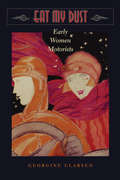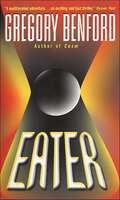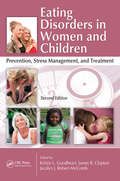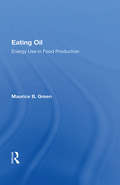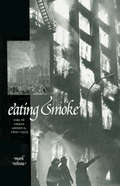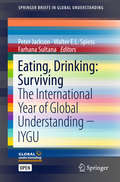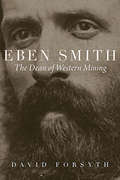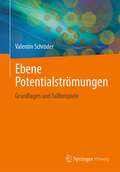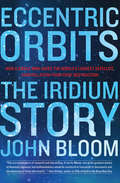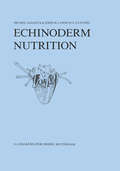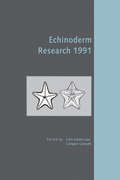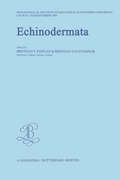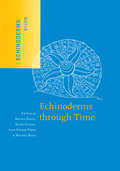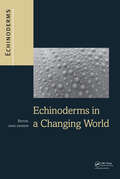- Table View
- List View
Eat My Dust: Early Women Motorists (The Johns Hopkins University Studies in Historical and Political Science #126)
by Georgine ClarsenThe history of the automobile would be incomplete without considering the influence of the car on the lives and careers of women in the earliest decades of the twentieth century. Illuminating the relationship between women and cars with case studies from across the globe, Eat My Dust challenges the received wisdom that men embraced automobile technology more naturally than did women.Georgine Clarsen highlights the personal stories of women from the United States, Britain, Australia, and colonial Africa from the early days of motoring until 1930. She notes the different ways in which these women embraced automobile technology in their national and cultural context. As mechanics and taxi drivers—like Australian Alice Anderson and Brit Sheila O'Neil—and long-distance adventurers and political activists—like South Africans Margaret Belcher and Ellen Budgell and American suffragist Sara Bard Field—women sought to define the technology in their own terms and according to their own needs. They challenged traditional notions of femininity through their love of cars and proved they were articulate, confident, and mechanically savvy motorists in their own right.More than new chapters in automobile history, these stories locate women motorists within twentieth-century debates about class, gender, sexuality, race, and nation.
Eat Up: The Inside Scoop on Rooftop Agriculture
by Lauren MandelFrom roof to table – urban food has reached new heights.Soaring prices and concerns about chemical-laden fruits and vegetables increasingly drive us to grow our own healthy food close to home. In cities, however, vanishing ground space and contaminated soils spur farmers, activists, and restaurateurs to look to the skyline for a solution. The hunger for local food has reached new heights, and rooftops can provide the space that cities need to bring fresh, organic produce to tables across North America.The first full-length book to focus entirely on rooftop agriculture, Eat Up views this growing movement through a practitioner's lens, explaining:Structural, access, and infrastructural considerationsZoning and building codesProven growing techniquesBusiness and marketing strategiesThis graphically rich guide provides inspiration and advice to aspiring growers through photographs of successful rooftop farms and gardens and interviews with industry professionals. Easy-to-use checklists and a decision tree are included to help gauge the viability of each unique rooftop opportunity. Essential reading for home gardeners, entrepreneurs, restaurateurs, policy makers, academics, and designers, Eat Up takes urban agriculture to a whole new level, proving that rooftop farming is not just pie in the sky—it is the future of urban food.Lauren Mandel holds a master's degree in landscape architecture from the University of Pennsylvania and a bachelor of arts degree in environmental science. She is a project manager and rooftop agriculture specialist at Roofmeadow, where she designs green roofs and oversees green roof and rooftop agriculture projects around the country.
Eat Your Science Homework: Recipes for Inquiring Minds (Eat Your Homework #2)
by Ann McCallumHungry readers discover delicious and distinct recipes in this witty companion to Eat Your Math Homework. Beginning with an overview of the scientific method and a primer in lab (sorry, kitchen) safety, this light-hearted cookbook will inspire a hunger for knowledge! A main text explains upper-elementary science concepts, including subatomic particles, acids and bases, black holes, and more. Alongside six kid-friendly recipes which encourage experiental learning and visual thinking, side-bars encourage readers to also experiment and explore outside of the kitchen. A review, glossary, and index make the entire book easy to digest.
Eater
by Gregory BenfordA scientist facing personal tragedy discovers a sentient black hole targeting humanity in this hard sci-fi thriller from &“a superb storyteller&” (Houston Post). Dr. Benjamin Knowlton&’s private world is crumbling around him. On the threshold of their greatest achievement, the renowned astrophysicist learns that his beloved wife and partner, Channing—an ex-astronaut-turned astronomer—is dying of cancer. Meanwhile, something looms alarmingly on the far edge of the solar system: at once a scientific find of unparalleled importance that could ensure the Knowltons&’ immortality, and a potential earth-shattering cataclysm that dwarfs their private one. For Benjamin and Channing have discovered &“Eater,&” an eons-old black hole anomaly that devours stars and worlds. Yet its most awesome and devasting secrets are still to be revealed . . . and feared.&“A celestial horror tale, a cosmological adventure, a literate end-of-the-world epic, and a story bursting with old-fashioned &‘sense of wonder.&’&” —Orlando Sentinel&“Benford spins poetry from textbook phenomena . . . [His] novel proves that scientific wisdom involves the heart and soul as well as the mind.&” —The Washington Post Book World&“The scientific equivalent of a taut police procedural . . . Benford&’s deft, suspenseful weaving of the struggle between Eater and humanity blends two threads with maximal impact.&” —Newark Star Ledger &“Even in the face of huge events and special effects sequences, Benford manages to keep the characters and the human-scale issues important . . . It&’s just this kind of juggling that characterizes the best of Benford&’s work . . . Eater is Benford&’s most Benfordesque book in quite a while.&” —Locus
Eating Disorders in Women and Children: Prevention, Stress Management, and Treatment, Second Edition
by Ljubisa R. RadovicOur understanding of eating disorders has improved markedly over the past 10 years since the publication of the previous edition of this volume. Early intervention is the key, as body dissatisfaction, obsession with thinness, and restrained and binge eating can be found in those as young as ten. Exploring prevention methods and therapeutic options, the second edition of Eating Disorders in Women and Children: Prevention, Stress Management, and Treatment is updated with new research on these devastating maladies.Highlights in the second edition include: An emphasis on the physiology of eating disorders and genetic factors related to anorexia and bulimia Theories on prevention and the identification of at-risk individuals The latest information on therapeutic modalities, including cognitive behavioral, interpersonal, constructionist, and narrative approaches as well as pharmaceutical management Nutritional evaluation and treatment Specific exercise recommendations for women and children with eating disorders An accompanying downloadable resources containing a PowerPoint® presentation for each chapter With contributions from acclaimed clinicians widely known for their work with the eating disorder population, this volume recognizes the multifaceted nature of these disorders, addresses the widening demographic range of those afflicted, and delves into the issues behind their development. It provides practical recommendations for treatment from many perspectives, presenting enormous hope for people who painfully struggle with these disorders. In addition, it explores critical measures that can be taken to help the larger population understand and work to prevent eating disorders in their communities.
Eating Oil: Energy Use In Food Production
by Maurice B. GreenThis book provides facts and figures to show how fast fossil fuel energy is being used up in the developed countries. It considers the problems of feeding the population of the developing countries to whom the expedient of using fossil fuel energy to boost food production is not available.
Eating Promiscuously: Adventures in the Future of Food
by James McWilliamsA bold and bracing argument for the complete reimagining of the human diet by the critically acclaimed author of Just Food The human practice of farming food has failed. There are 7,500 known varieties of domesticated apples; we regularly eat about five. Seventy–five percent of the world's food derives from five animals and twelve plants. Factory farmed meat is a major source of greenhouse gas emissions (about 14 percent, larger than transportation) and consumes 75 percent of the water in drought–prone regions such as the West. We are struck in a rut of limited choices, ad the vast majority of what we eat is detrimental to our health and the welfare of the planet. But what if we could eliminate agriculture as we know it? What if we could start over?James McWilliams's search for more expansive palate leads him to those who are actively exploring the fringes of what we can eat, a group of outliers seeking nutrition innovation outside the industrial food system. Here, we meet insect manufacturers, seaweed harvesters, road kill foragers, plant biologists, and oyster farmers who seek to open both our minds and our mouths—and to overturn our most basic assumptions about food, health, and ethics. Eating Promiscously generates hope for a more tasteful future—one in which we eat thousands of foods rather than dozens—with a new philosophy that could save both ourselves and our planet.
Eating Smoke: Fire in Urban America, 1800–1950
by Mark TebeauDuring the period of America's swiftest industrialization and urban growth, fire struck fear in the hearts of city dwellers as did no other calamity. Before the Civil War, sweeping blazes destroyed more than $200 million in property in the nation's largest cities. Between 1871 and 1906, conflagrations left Chicago, Boston, Baltimore, and San Francisco in ruins. Into the twentieth century, this dynamic hazard intensified as cities grew taller and more populous, confounding those who battled it. Firefighters' death-defying feats captured the popular imagination but too often failed to provide more than symbolic protection. Hundreds of fire insurance companies went bankrupt because they could not adequately deal with the effects of even smaller blazes.Firefighters and fire insurers created a physical and cultural infrastructure whose legacy—in the form of heroic firefighters, insurance policies, building standards, and fire hydrants—lives on in the urban built environment. In Eating Smoke, Mark Tebeau shows how the changing practices of firefighters and fire insurers shaped the built landscape of American cities, the growth of municipal institutions, and the experience of urban life. Drawing on a wealth of fire department and insurance company archives, he contrasts the invention of a heroic culture of firefighters with the rational organizational strategies by fire underwriters. Recognizing the complexity of shifting urban environments and constantly experimenting with tools and tactics, firefighters fought fire ever more aggressively—"eating smoke" when they ventured deep into burning buildings or when they scaled ladders to perform harrowing rescues. In sharp contrast to the manly valor of firefighters, insurers argued that the risk was quantifiable, measurable, and predictable. Underwriters managed hazard with statistics, maps, and trade associations, and they eventually agitated for building codes and other reforms, which cities throughout the nation implemented in the twentieth century. Although they remained icons of heroism, firefighters' cultural and institutional authority slowly diminished. Americans had begun to imagine fire risk as an economic abstraction.By comparing the simple skills employed by firefighters—climbing ladders and manipulating hoses—with the mundane technologies—maps and accounting charts—of insurers, the author demonstrates that the daily routines of both groups were instrumental in making intense urban and industrial expansion a less precarious endeavor.
Eating Tomorrow: Agribusiness, Family Farmers, and the Battle for the Future of Food
by Timothy A. Wise<p>A major new book that shows the world already has the tools to feed itself, without expanding industrial agriculture or adopting genetically modified seeds, from the Small Planet Institute expert <p>Few challenges are more daunting than feeding a global population projected to reach 9.7 billion in 2050--at a time when climate change is making it increasingly difficult to successfully grow crops. In response, corporate and philanthropic leaders have called for major investments in industrial agriculture, including genetically modified seed technologies. Reporting from Africa, Mexico, India, and the United States, Timothy A. Wise's Eating Tomorrow discovers how in country after country agribusiness and its well-heeled philanthropic promoters have hijacked food policies to feed corporate interests. <p>Most of the world, Wise reveals, is fed by hundreds of millions of small-scale farmers, people with few resources and simple tools but a keen understanding of what and how to grow food. These same farmers--who already grow more than 70 percent of the food eaten in developing countries--can show the way forward as the world warms and population increases. Wise takes readers to remote villages to see how farmers are rebuilding soils with ecologically sound practices and nourishing a diversity of native crops without chemicals or imported seeds. They are growing more and healthier food; in the process, they are not just victims in the climate drama but protagonists who have much to teach us all.</p>
Eating for Pleasure, People & Planet
by Tom Hunt'If we could all live and eat a little more like Tom the world and the food chain would be in much better shape.' Anna Jones'This book is like a hybrid of Michael Pollan and Anna Jones. It combines serious food politics with flavour-packed modern recipes. This is a call-to-arms for a different way of eating which seeks to lead us there not through lectures but through a love of food, in all its vibrancy and variety.' Bee WilsonTom's mission is to teach a way of eating that prioritises the environment without sacrificing pleasure, taste and nutrition.Tom's manifesto, 'Root to Fruit' demonstrates how we can all become part of the solution, supporting a delicious, biodiverse and regenerative food system, giving us the skills and knowledge to shop, eat and cook sustainably, whilst eating healthier, better-tasting food for no extra cost.
Eating the Ocean: Seafood and Consumer Culture in Canada (La collection Louis J. Robichaud/The Louis J. Robichaud Series)
by Brian PayneDuring the first half of the twentieth century, Canadian fisheries regularly produced more fish than markets could absorb, driving down profits and wages. To address this, both industry and government sought to stimulate domestic consumption via increased advertising. In Eating the Ocean Brian Payne explores how government-funded marketing called upon Canadian housewives to prepare more seafood meals to improve family health and aid an industry central to Canadian identity and heritage. The goal was first to make seafood a central element of a “wholesome” diet as a solution to a perceived nutritional crisis, and, second, to aid industry recovery and growth while decreasing Canadian fisheries’ dependency on foreign markets. But fishery managers and policymakers fundamentally miscalculated consumer demand, wrongly assuming that Canadians could and would eat more seafood. Fisheries continued to extract more fish than the environment and the market could sustain, and the collapse of the nation’s fisheries that we are now seeing has as much to do with failed assessments of market demand as it does with faulty extraction practices. Using internal communications between industry leaders and Ottawa bureaucrats, as well as advertising and promotional material published in the nation’s leading magazines, national and local newspapers, and radio programming, Eating the Ocean traces the flawed understanding of not only supply but demand, a misguided gamble that caused fisheries to become the most mismanaged resource economy in early-twentieth-century Canada.
Eating, Drinking: The International Year of Global Understanding - IYGU (SpringerBriefs in Global Understanding)
by Peter Jackson, Walter E.L. Spiess and Farhana SultanaThis publication addresses the global challenges of food and water security in a rapidly changing and complex world. The essays highlight the links between bio-physical and socio-cultural processes, making connections between local and global scales, and focusing on the everyday practices of eating and drinking, essential for human survival. Written by international experts, each contribution is research-based but accessible to the general public.
Eben Smith: The Dean of Western Mining (Mining the American West)
by David ForsythDavid Forsyth recounts the life of Eben Smith, an integral but little-known figure in Colorado mining history. Smith was one of the many fortune seekers who traveled to California during the gold rush and one of the few who found what he sought. He moved to Colorado in 1860 with business partner Jerome Chaffee and over the next forty-six years was involved in mining in nearly every major camp in the state, from Central City to Cripple Creek, and in the development of mines such as the Bobtail, Little Jonny, and Victor. He was eulogized by the Denver Post and Denver Times as the “dean of mining in Colorado.” The mining teams Smith formed with Chaffee and with industrialist David Moffat were among the most successful and respected in Colorado, and many in the state held Smith in high regard. Yet despite the credit he received during his lifetime for establishing Colorado’s mining industry, Smith has not received much attention from historians, perhaps because he was content to leave public-facing duties to his partners while he concerned himself with managing mine operations. From Smith’s early years and his labor in the mines to his rise to prominence as an investor and developer, Forsyth shows how Smith used the mining and milling knowledge he acquired in California to become a leader in technological innovation in Colorado’s mining industry.
Ebene Potentialströmungen: Grundlagen und Fallbeispiele
by Valentin SchröderDas Buch zielt darauf ab, Studierenden des Maschinenbaus, der Verfahrens- und Umwelttechnik sowie des Wasserbaus den Einstieg in das Thema ebener Potentialströmungen zu vermitteln. Hierbei werden grundlegende Zusammenhänge (z.B. Stromfunktion, Potentialfunktion, usw.) abgeleitet. Dies geschieht in detaillierter Vorgehensweise („Step by Step“), sodass der Leser beim Nachvollziehen der Ableitungsschritte auf keine Verständnisschwierigkeiten stoßen sollte. Mathematische Grundlagen der Ingenieurwissenschaften werden bei der Benutzung des Buchs vorausgesetzt. Neben dem genannten Basiswissen ebener Potentialströmungen tragen zahlreiche Anwendungsbeispiele zum besseren Verständnis der Grundlagen bei. Auch hier wird großer Wert auf eine gut strukturierte, leicht nachvollziehbare Vorgehensweise gelegt. In den meisten Fällen kommt hierbei ein Tabellenkalkulationsprogramm zum Einsatz, was sich als eine nicht zu unterschätzende Hilfe erweist.
Eccentric Orbits: The Iridium Story
by John Bloom“In the early 1990s, Motorola, the legendary American technology company developed a revolutionary satellite system called Iridium that promised to be its crowning achievement. Light years ahead of anything previously put into space, and built on technology developed for Ronald Reagan’s “Star Wars,” Iridium’s constellation of 66 satellites in polar orbit meant that no matter where you were on Earth, at least one satellite was always overhead, and you could call Tibet from Fiji without a delay and without your call ever touching a wire. ridium the satellite system was a mind-boggling technical accomplishment, surely the future of communication. The only problem was that Iridium the company was a commercial disaster. Only months after launching service, it was $11 billion in debt, burning through $100 million a month and crippled by baroque rate plans and agreements that forced calls through Moscow, Beijing, Fucino, Italy, and elsewhere. Bankruptcy was inevitable—the largest to that point in American history. And when no real buyers seemed to materialize, it looked like Iridium would go down as just a “science experiment.” That is, until Dan Colussy got a wild idea. Colussy, a former head of Pan-Am now retired and working on his golf game in Palm Beach, heard about Motorola’s plans to “de-orbit” the system and decided he would buy Iridium and somehow turn around one of the biggest blunders in the history of business. In “Eccentric Orbits”, John Bloom masterfully traces the conception, development, and launching of Iridium and Colussy’s tireless efforts to stop it from being destroyed, from meetings with his motley investor group, to the Clinton White House, to the Pentagon, to the hunt for customers in special ops, shipping, aviation, mining, search and rescue—anyone who would need a durable phone at the end of the Earth. Impeccably researched and wonderfully told, “Eccentric Orbits” is a rollicking, unforgettable tale of technological achievement, business failure, the military-industrial complex, and one of the greatest deals of all time.
Echinoderm Aquaculture
by Nicholas Brown Steve EddySea urchins and sea cucumbers are highly sought after delicacies growing in popularity globally. The demand for these species is rapidly outpacing natural stocks, and researchers and seafood industry personnel are now looking towards aquaculture as a means of providing a sustainable supply of these organism. Echinoderm Aquaculture is a practical reference on the basic biology and current culture practices for a wide range of geographically diverse echinoderm species. Echinoderm Aquaculture begins by examining the basic ecology and biology of sea urchins and sea cucumbers as well as the breadth of uses of these organisms as a source of food and bioactive compound. Subsequent chapters delineate the specific species of interest invarious geographic regions from around the world. Together, chapters provide a comprehensive coverage of culture practices. Echinoderm Aquaculture is a practical reference for researchers and industry personnel, and will serve as an invaluable resource to this rapidly growing segment of the aquaculture industry.
Echinoderm Nutrition
by John M. Lawrence Michel JangouxThe purpose of this book is to present the state of knowledge concerning nutrition and point out directions for future work for the Echinodermata, an ancient group which shows great diversity in form and function, and whose feeding activities can have great environmental impact.
Echinoderm Research
by Michel JangouxThis book is an outcome of the second European conference on Echinoderm brussels held in Belgium in 1989. It covers the following areas of research in echinoderm: paleontology, reproduction, development and larval biology, evolution, systematics and biogeography, morphology and physiology.
Echinoderm Research 1991
by L. Scalera-LiaciA selection of papers, reports and posters presented at the third European conference on echinoderms - a thorny-skinned group of marine animals considered of great zoological interest. The contributions look at morphology, development biology, ecology and symbiosis.
Echinoderm studies 1 (1983)
by John M. Lawrence Michel JangouxThis work consists of seven plenary lectures read at an international conference in Tampa, USA.
Echinoderm studies 4 (1993)
by Michel JangouxEchinoderm Studies is a biennial series in which comprehensive surveys of selected topics are presented. A guiding principle of the series is to cover all aspects of echinoderm biology so as to promote a better comprehension of this group of animals.
Echinoderm studies 5 (1996)
by Michel JangouxPart of a biennial series in which surveys of selected topics are presented, this volume discusses: velatida and spinulosida; adhesion in echinoderms; biological activities and biological role of triterpene glycosides from holothuroids (echinodermata); mass mortality of echinoderms from abiotic factors; mutable collagenous tissue; and extracellular matrix as mechano-effector.
Echinodermata
by EchinodermataThis book is a compilation of proceedings that contain abstracts of all papers/posters presented at the International Echinoderm Conference held in 1984 and complete papers from those submitted for publication and accepted on the recommendations of referees.
Echinoderms Through Time
by Bruno David Alain Guille Jean-Pierre FeralEchinoderms are now considered as a biological and geological model that underlies researches of primary importance. The extent of the contributions made by the International Echinoderm Conferences to various fields of research is attested by the scope covered by presentation at the international conferences. These proceedings contain the complete papers or abstracts of all the presentations and posters presented at the eighth International Echinoderm Conference, held in Dijon, France in September, 1994. Coverage includes: general; extinct classes; crinoids; asteroids; ophiuroids; holothuroids; and echinoids.
Echinoderms in a Changing World: Proceedings of the 13th International Echinoderm Conference, January 5-9 2009, University of Tasmania, Hobart Tasmania, Australia
by Craig JohnsonEchinoderms are an ancient and diverse group of marine animals with a rich fossil record. They occur abundantly in all modern oceans and at all depths, where they contribute importantly to patterns in biodiversity and to the structure and functioning of marine systems. It is therefore vital to understand how they will respond to a rapidly cha
